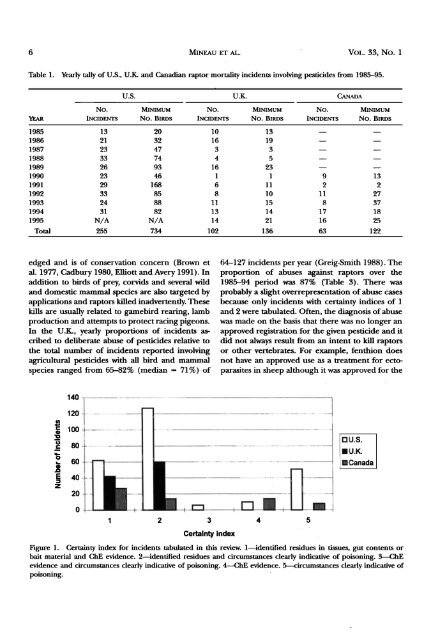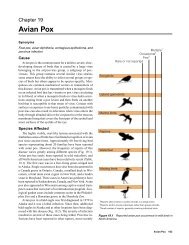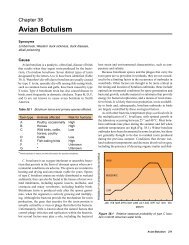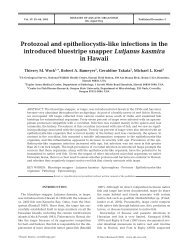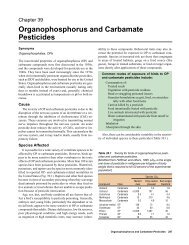poisoning of raptors with organophosphorus and carbamate ...
poisoning of raptors with organophosphorus and carbamate ...
poisoning of raptors with organophosphorus and carbamate ...
You also want an ePaper? Increase the reach of your titles
YUMPU automatically turns print PDFs into web optimized ePapers that Google loves.
6 MINEAU ET AL. VOL. 33, No. 1<br />
Table 1. Yearly tally <strong>of</strong> U.S., U.K. <strong>and</strong> Canadian raptor mortality incidents involving pesticides from 1985-95.<br />
U.S. U.K. CANADA<br />
No. MINIMUM NO. MINIMUM NO. MINIMUM<br />
YEAR INCIDENTS NO. BIRDS INCIDENTS NO. BIRDS INCIDENTS NO. BIRDS<br />
1985 13 20 10 13 -- --<br />
1986 21 32 16 19 -- --<br />
1987 23 47 3 3 -- --<br />
1988 33 74 4 5 -- --<br />
1989 26 93 16 23 -- --<br />
1990 23 46 1 1 9 13<br />
1991 29 168 6 11 2 2<br />
1992 33 85 8 10 11 27<br />
1993 24 88 11 15 8 37<br />
1994 31 82 13 14 17 18<br />
1995 N/A N/A 14 21 16 25<br />
Total 255 734 102 136 63 122<br />
edged <strong>and</strong> is <strong>of</strong> conservation concern (Brown et<br />
al. 1977, Cadbury 1980, Elliott <strong>and</strong> Avery 1991). In<br />
addition to birds <strong>of</strong> prey, corvids <strong>and</strong> several wild<br />
<strong>and</strong> domestic mammal species are also targeted by<br />
applications <strong>and</strong> <strong>raptors</strong> killed inadvertently. These<br />
kills are usually related to gamebird rearing, lamb<br />
production <strong>and</strong> attempts to protect racing pigeons.<br />
In the U.K., yearly proportions <strong>of</strong> incidents ascribed<br />
to deliberate abuse <strong>of</strong> pesticides relative to<br />
the total number <strong>of</strong> incidents reported involving<br />
agricultural pesticides <strong>with</strong> all bird <strong>and</strong> mammal<br />
species ranged from 65-82% (median = 71%) <strong>of</strong><br />
64-127 incidents per year (Greig-Smith 1988). The<br />
proportion <strong>of</strong> abuses against <strong>raptors</strong> over the<br />
1985-94 period was 87% (Table 3). There was<br />
probably a slight overrepresentation <strong>of</strong> abuse cases<br />
because only incidents <strong>with</strong> certainty indices <strong>of</strong> 1<br />
<strong>and</strong> 2 were tabulated. Often, the diagnosis <strong>of</strong> abuse<br />
was made on the basis that there was no longer an<br />
approved registration for the given pesticide <strong>and</strong> it<br />
did not always result from an intent to kill <strong>raptors</strong><br />
or other vertebrates. For example, fenthion does<br />
not have an approved use as a treatment for ectoparasites<br />
in sheep although it was approved for the<br />
140<br />
120<br />
[3U.S.<br />
6O<br />
IU.K.<br />
[]Canada<br />
4O<br />
2O<br />
0<br />
I 2<br />
3 4<br />
Certainty index<br />
Figure 1. Certainty index for incidents tabulated in this review. 1---identified residues in tissues, gut contents or<br />
bait material <strong>and</strong> ChE evidence. 2--identified residues <strong>and</strong> circumstances clearly indicative <strong>of</strong> <strong>poisoning</strong>. 3--ChE<br />
evidence <strong>and</strong> circumstances clearly indicative <strong>of</strong> <strong>poisoning</strong>. 4--ChE evidence. 5--circumstances clearly indicative <strong>of</strong><br />
<strong>poisoning</strong>.


